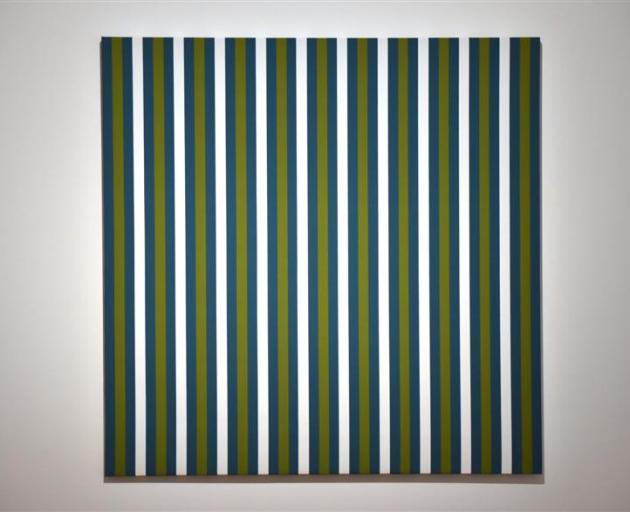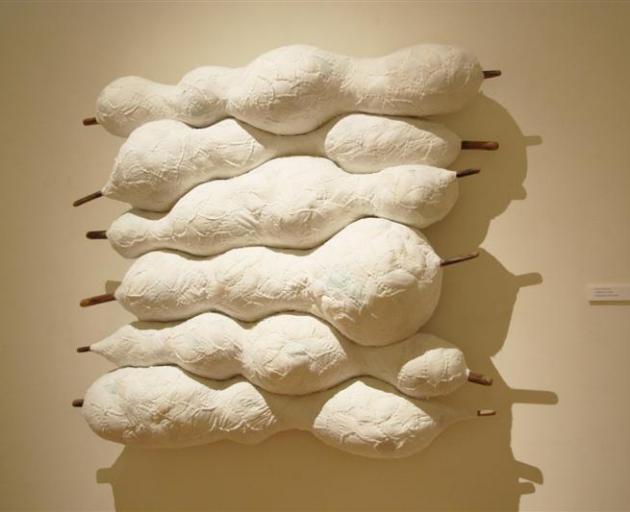
''Study of a Samoan Savage'', Yuki Kihara (Milford Galleries)
A new series of photographic and video works by multidisciplinary artist Yuki Kihara sees the artist continue her exploration of the history of representation in the Pacific Islands.
Focusing on a central mythical character, Study of a Samoan Savage records Kihara's Maui figure, a Polynesian demi-god, in a series of actions and poses that reflect on historical representations of Samoan men, as well as traditional Samoan dance and contemporary culture.
The use of photography to measure and subjugate indigenous people was common practice in the 19th century.
Kihara reproduces the style of these images in a series of works that feature Maui with measuring tools, focusing on particular characteristics of the figure.
A Vernier caliper measures the width and length of his nose, his skin is pinched by a skinfold caliper, and his body is revealed in a triptych of full-length portraits.
Maui Descending a Staircase I (After Duchamp) and the silent video work Maui Descending a Staircase II (After Duchamp) reference European modern art, but also the work of photographers such as Eadweard Muybridge, whose pioneering stop-motion photography made way for anthropologists to study variances in human movement.
Like Kihara's 2012 video work Siva in Motion, which also referenced stop-motion photography, these new video and movement photographs are historically nuanced and aesthetically captivating.
Kihara continues to be a socially and historically critical and engaging artist with works that have a strong visual impact.

''Wanderings'', (Dunedin Public Art Gallery)
The Dunedin Public Art Gallery has gathered a series of works from its collection that reflect on how travel has shaped or informed a range of artistic practices.
Spanning from 19th-century surveyor drawings through to modern and contemporary art, the exhibition is an eclectic series of works, but with informative wall texts is able to share some interesting reflections on the wanderings of artists.
Beyond illustrative records, a series of early 20th-century paintings by John Weeks show the artist recording European experiences and places in a style that is heavily influenced by modernist European paint practices of the time.
Ani O'Neill's Kua marino te tai is a woven sheet of stars that blends contemporary materials with Polynesian navigation methods.
Similarly, Andrew Drummond's Mementos from the Crossing sees blue and gold lines etched into a series of marble vignettes, stylistically similar to a map, but actually representing a series of trophies or adornments.
From this century, contemporary drawings and a signpost sculpture by John Reynolds turn familiar road signs into unpractical parodies that see no value in getting you to a destination, providing only humour for the journey.
The themes of this exhibition are particularly interesting when considering international residencies and programmes that artists today regularly undertake, such as DPAG's Visiting Artist Programme, which is now in its 20th year.

Works* by Motoko Watanabe (Forrester Gallery, Oamaru)
Dunedin artist Motoko Watanabe presents a collection of five woven sculptures in a new exhibition at the Forester Gallery.
Trained as an illustrator, Watanabe began making small baskets at home from organic materials found in her garden.
Her practice has since expanded to the large installation pieces of the current exhibition.
The smallest work is a group of stalagmite-like pieces arranged on the floor, all below knee height.
Then, Untitled No. 4 is a tower of eight circular baskets that reach from the floor to the high gallery ceiling.
Untitled No. 2a and Unititled No. 2b are two conical works that are mounted at opposite ends of the gallery space.
Immensely tall and wide, they are impressive in themselves but together create a tension in the space between.
Watanabe uses recycled and second-hand fabrics, which she says are plentiful and inexpensive but also fascinating as they have an unknown history.
Her conscious use of these fabrics sees the raw materials become a central focus of the work.
The fabrics can be seen through the mix of different colours between off-white and beige in each piece. It is difficult to see where the fabrics begin and end in the tightly woven pattern made by Watanabe, but the weaving process begins to deconstruct as attention is placed on details of form.
* This exhibition has no formal title.
by Samantha McKegg












